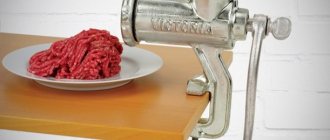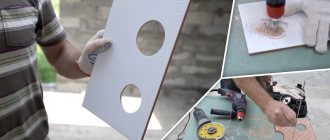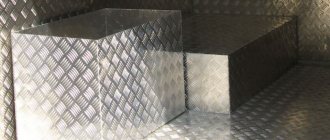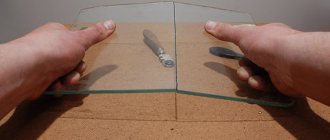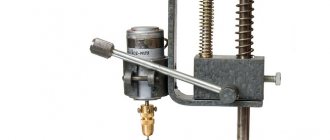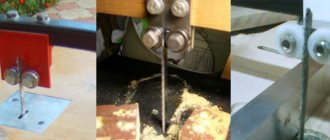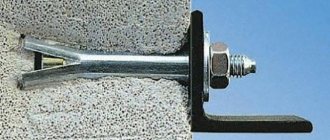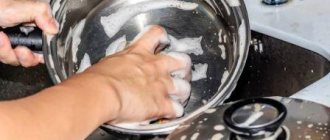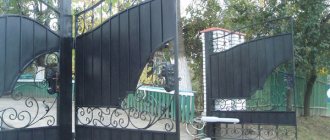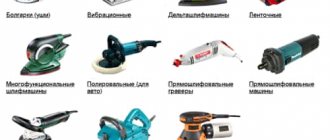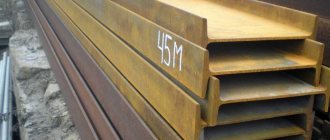If you don’t know how to assemble a manual meat grinder, read the instructions in the article
A meat grinder remains a permanent attribute of any housewife busy in the kitchen. Despite the existence of a large number of different designs and the growing popularity of electric models, the classic meat grinder with a mechanical operating principle is still the most common. And all thanks to comparable ease of use, availability and reliability.
If there is a power outage or the electric meat grinder breaks down, a mechanical meat grinder will come to the rescue. Read below about how to properly assemble such a structure, and you will also learn about the correct purpose of all the main and additional parts.
How to properly insert a knife into a manual meat grinder
Despite the different principles of operation of a meat grinder, it is necessary to carefully study the assembly instructions for any device, since the efficiency of its operation depends on the correct composition
. It is especially important to know how the knife should be positioned in a meat grinder. This is the most important element of any type of device
The mechanical importance of the assembly is no less than the electrical one. The quality of the prepared dish will depend on how you insert a knife into a manual meat grinder.
And also the durability of the device. To sequentially assemble the parts of a manual meat grinder, you need to know what it consists of:
- The main body of the meat grinder into which all parts are attached. Often it is made of cast iron, but there are also examples made of aluminum.
- Spiral shaft for scrolling contents. It is also known by another name - auger.
- Cross knife.
- Grid plate - for adjusting the degree of grinding of meat and other products in the device.
- Fixer of all parts.
- The handle that sets the meat grinder in motion.
To assemble a manual meat grinder, you must first insert the auger into the device body. Then put a knife on top of it
Particular attention should be paid to which side to insert the knife into the meat grinder - this is very important. If the tip of the part is sharpened only on one side, then the sharp part is installed on the shaft side for a softer movement when grinding. If the knife is double-edged, then it doesn't matter which side you put it on.
If the knife is double-edged, then it doesn't matter which side you put it on.
After installing the cutting part according to the grooves, the grid is installed and the structure is secured with a union nut
It is very important to install the grid as tightly as possible to the cutting part.
The last thing to attach is the moving handle.
Disassembly and cleaning
After you have used the device, you must disassemble and clean it. Under no circumstances should the device be washed when assembled. It is simply unrealistic to thoroughly wash the device from minced meat residues, and if we are talking about an electrical device, such negligence can also cause a short circuit.
The disassembly procedure is as follows:
- If the design is equipped with a removable meat receiver, you need to remove it from the neck of the meat grinder.
- Unscrew the clamping nut.
- Remove the grill and cutting part. Unscrew the screw that holds the handle.
- Remove the auger from the housing.
- Wash all parts. To clean the grate more thoroughly, you can use a match or toothpick.
- Place the washed components on a napkin and leave to dry.
Important! Assembling a meat grinder - manual or electric - is unacceptable if the parts have not yet had time to dry. A mechanical meat grinder can rust, and a short circuit can occur in an electrical appliance.
serviceyard.net
How to assemble a meat grinder correctly
The assembly principle is quite simple - you can figure it out without any problems if you have assembled a conventional manual meat grinder of an old modification at least once.
For clarity, I will give you a photo with a diagram of how to assemble a meat grinder:
How to properly assemble a meat grinder - instructions:
First, connect the gearbox housing to the auger housing, its end should be immersed in the gearbox groove. Once the parts are in the desired position, turn the auger clockwise until you hear a click. If you installed the parts incorrectly, you will not be able to turn the auger. When you put the auger in place, make sure that the protrusion coincides with the hole in the housing
Otherwise the shaft will not work. You need to put a blade and a grid on the other end of the auger so that all the holes and protrusions match, and it is important to install the knife with the correct side of the blade. The photo shows how to correctly place a knife in an electric meat grinder.
Now the structure can be fixed with a clamping nut. Install the loading tray and check the build quality
If you hear uncharacteristic knocking or clinking noises during operation, disassemble the meat grinder and try again.
Additional items
Some models of manual and electric meat grinders offer the possibility of preparing more or less chopped product. For this purpose, the kit may include additional structural elements:
- double-sided knives;
- gratings with a set of holes of different diameters;
- extra rings and extra knives.
The assembly order, accordingly, changes slightly. To obtain more finely ground minced meat, additional knives and grates, separated by special rings, can be inserted into the unit. The instructions included with the device must contain a picture diagram describing how to assemble an electric meat grinder with additional structural elements. Typically the build order looks like this:
- insert the auger into the housing;
- put a ring with the largest slots on the auger (usually 3 or 4);
- put on a double-sided knife;
- grille with middle holes;
- second knife;
- grille with the smallest holes;
- clamp ring.
In all cases, the flat side of the knife should be against the grate. If the design provides for multifunctionality, there may be other assembly options. For example, to prepare cookies, instead of a regular wire rack, rings with shaped slots are put on, and a knife is not used at all. Instead, a thrust ring made of metal or plastic is inserted into the body.
When you purchase a meat grinder, try not to lose the instruction manual.
Usually this document contains picture diagrams indicating the sequence of correct assembly of your particular device. Until assembling the unit becomes a habit for you, it is better to have a similar diagram before your eyes. views
What does a meat grinder consist of and what is the purpose of the parts?
What does a classic hand-held device consist of:
- Building: A. Meat receiving area; B. Fastening clamp;
- Lever;
- Auger with left-hand thread;
- Bearing bushing;
- Cutting knife with 4 blades;
- Lattice;
- Union nut;
- Eye bolt for attaching the handle
Meat grinder disassembled
The device can also be supplied with additional grates with different hole diameters, knives, attachments for making sausages, frankfurters and freshly squeezed juice.
The attachments must be sharpened regularly and should not be used for cutting too hard or stringy semi-finished meat products.
The screw shaft is an important and basic part. It has the appearance of a spiral, which during operation grinds excess meat, moving it towards the nozzles with knives. It is this mechanism that requires the use of durable metal.
Screw shaft - conductor of products inside the device
Knife and special cutting attachments. They do all the work of grinding, cutting and crushing meat or any other products. It is made mainly from stainless materials. It is necessary to sharpen knives for better and high-quality work, even though the steel is sharpened on the grate during rotation.
The knife must be installed correctly, otherwise the device may jam
The structure of the knife and its shape affect the grinding of the product. For example, if a knife has a curved blade, it means that it will easily chop the veins and fibers of meat, while preventing the auger shaft from clogging.
The grid has three types of hole diameters:
- Very large - 12 mm. Grille with three or four holes. Used for stuffing sausages. Not always included.
- Large holes - 8 mm. This rack is ideal for preparing sausage mince.
- The middle holes are 4-4.5 mm. Universal grid. Suitable for preparing minced meat for cutlets. Included.
- Small holes - 3 mm. Pate lattice. It is ideal for making pate or puree.
Using these grates you can get coarse or finely ground minced meat. It all depends on your preferences
The nut (fixing ring) clamps and secures the grid, knife and auger shaft. Sometimes it can be difficult to unscrew it after finishing work. But this problem can easily be solved with the help of ordinary cloth thrown over the nut. So, the hand does not slip, and the part can be easily unscrewed.
A manual cast iron or aluminum meat grinder, especially from Soviet times, is attached to the work surface using a threaded device (foot). And therefore, in order to prevent the device from moving on the table, you need to place something under the metal base. This can be a newspaper folded several times. In modern models, the mounting base is plastic or rubber, and therefore the device is attached to the table much more securely.
How to make a sausage attachment from a plastic bottle
If you don’t have a special attachment for making sausages, you can make it yourself.
Manufacturing
You can make such a nozzle in a few minutes:
- Cut off the cylindrical part of the bottle from the neck.
- Place the mesh inside and install it perpendicular to the longitudinal axis of the bottle.
- Use a marker to mark the point of contact between the mesh and the bottle.
- Use scissors to cut the bottle along the line.
To prepare thin sausages, insert a 20 ml syringe with a cut off end into the bottle.
Any plastic bottle is suitable for making this device, but it is better to choose one with a long, thin neck. This makes it easier to put the gut on it.
Sausage attachment from a plastic bottle
How to put it on a meat grinder
This device is put on and used in the same way as a conventional device:
- Unscrew the nut that secures the grille.
- Place the bottleneck inside it.
- Screw the nut into place without applying any physical force.
Using this device you can prepare all types of sausages, including raw smoked and dry-cured sausages. The calorie content of raw smoked sausage is high enough to replace heavier stew and perishable boiled sausage on a hike.
Homemade sausage attachment from a bottle
Design
Before assembling a meat grinder, you need to study its design. Since the times of the USSR, we were well aware of the old, but very reliable Soviet design - a manual version that still helps users in the kitchen today. Then its analogues began to appear, but only with an electric drive, but the main details remained the same.
- The one-piece body was made of cast iron, then they switched to various alloys based on light and durable aluminum. In the upper part of it there is the neck of the meat receiver, where processed products are placed.
- An auger is a specially shaped shaft that, when rotated, propels products toward the exit of the product.
- At its end, a knife is put on, which performs the grinding - it can be disk or with wings.
- The grid regulates the degree of grinding of products; instead, shaped devices are inserted into the meat grinder when working with dough.
- A round-shaped clamping device is used to securely fix all elements in the housing. There are special protrusions on it for easy fastening.
- A handle is attached to the rear of the shaft with a special wing screw to rotate the entire mechanism.
In electric meat grinders, the set of main parts is identical, they must be assembled in exactly the same way, the only difference is in the drive and the housing, which is made of hard plastic. Such a device is controlled using keys located on a special panel, and rotation is carried out by an electric motor.
Important! The manual version of the product is installed on the edge of the table and secured using a special threaded device. Material must be placed under the metal base to prevent the product from moving on the table
Operating principle of a manual meat grinder
One of the main elements and functional parts of the meat grinder is the screw shaft; it moves pieces of meat to special knives, which are fixed at the end of the shaft on special attachments. Thus, slowly but surely the raw material reaches the grinding and forming mesh. It comes in different shapes and hole sizes so that you can choose the desired consistency of the future minced meat.
All elements of a manual meat grinder are standard; they may differ only in the set of additional accessories
When purchasing a manual meat grinder, pay attention to the quality of the material from which the body and main parts are made. Even in a plastic meat grinder, knives and grids must be metal
Otherwise, such a meat grinder can simply be handed over to a toy store.
Even in a plastic meat grinder, the knives and grids must be metal. Otherwise, such a meat grinder can simply be handed over to a toy store.
Unlike older models, some modern variations are equipped with siphons for squeezing juices or are used instead of a grater. Most of these devices, of course, are produced for electric drive, but you can also find manual and mechanical models.
Types of meat grinders
Since meat grinders have been around for a very long time, there are many types of them. In addition, they tried to replace them with combines and blenders. And the manufacturers of meat grinders had to come up with as many interesting functions and “tricks” for them so that they would not lose their necessity. They are equipped with a huge number of knives and attachments, which give the devices incredible functionality and ease of use. With them you can turn meat into minced meat, make sausages and pasta. In addition, they can be used to prepare homemade sausage and even juices and purees. But in order not to get confused in the many types of these devices, we will consider two global and main types of these devices.
These are manual and electrical appliances. It is the latter that are now super popular among most people. In order to twist the meat with them, you do not need to exert much physical effort to stuff the sausage and twist it. Just press the “Start” button and watch the process of preparing minced meat. True, they also have a number of disadvantages. For example, if you missed a bone, the device will definitely be damaged because it will not be able to cope with it. Besides, if the lights in the house suddenly turn off, you won’t be able to make minced meat. And sometimes the motor in the devices burns out, and then you just need to buy a new one.
For many, mechanical Soviet models (knowing how to assemble them correctly is very important) are antiquities that it’s time to forget. However, they are incredibly reliable and durable.
This has been proven in practice. And it is almost impossible to break them. The only thing that can become faulty is the knives. But you can sharpen them yourself at home. And they will last for a very long time.
As a rule, their body material is cast iron, stainless steel or durable plastic. However, some can be made from aluminum. Cast iron devices are almost impossible to break. They are practically eternal. And many people love them and consider them much better than their electric counterparts. But they are very heavy. And they can be a little tricky to install. You may even have to ask a man for help every time you install and remove it. Although maybe this is better. But modern aluminum devices are much lighter. Here you no longer have to put in additional physical effort. At the same time, they can serve you just as long as steel or cast iron and do their job with the highest quality.
As for plastic models, they are lightweight and functional. But at the same time, they are very fragile, they must be handled with extreme care, and they must be avoided from falling or sharp blows.
Devices also differ in power
It is important to know how much meat you plan to process. For example, if the power of the device is 1000 W, then you can grind up to 1.3 kg of meat without fear that something will break
Each device has a power reserve, which will be needed if veins or cartilage get into pieces of meat. In this case, the device goes to maximum operation. This is very harmful for him. So try to avoid this.
Devices are also divided into household and professional. The latter have much greater power. They are needed so that the kitchens of restaurants and cafes can quickly process orders and prepare dishes. But the first ones are not so powerful, they are much smaller in size, but are ideal for use in the home. Moreover, you don’t need any huge power in everyday life; you won’t be doing too much work.
Also, some models are equipped with a reverse system. It allows the screw in the meat grinder to rotate in the opposite direction. This helps a lot if veins accidentally get into pieces of meat. The device slows down, and you can get them out.
Proper care
Having figured out how to assemble an electric meat grinder, now you need to figure out the correct dismantling process
, because all the insides of the mechanical unit must be cleaned of residues after grinding. Disassembling the product is carried out in the reverse order:
- first remove the bowl, then press the rotation lock button at the top of the main body and disconnect the mechanical part;
- Now you can unscrew the clamping nut so that it does not slip in your hand (use a clean rag);
- then the internal parts are removed and cleaned of any remaining crushed products;
- Now you can wash all parts with warm water and detergent;
- After rinsing, the parts are placed on a towel until completely dry.
Disassembling a manual analogue is practically no different from the process of dismantling the mechanical part of an electrical product described above. Many people, after the parts have dried, store the device assembled until future use. Experts advise storing all parts in an unassembled state, and during assembly, lubricate the auger with vegetable oil before use. Such care, as a rule, extends the life of the product.
A manual meat grinder is a necessary tool in the kitchen, because, unlike an electric one, it will never stop working due to power outages
Most modern hand-held devices are made of high-quality and reliable material to last for centuries. There are also modern meat grinders made of durable plastic. Such a meat grinder, of course, is easier to break than a cast iron one. Therefore, you should handle it more carefully.
Manual cast iron meat grinder
A cast iron meat grinder is a faithful assistant in the kitchen. It will serve for a very long time. And to break it, you need to try very hard. This is her advantage. The disadvantage of a cast iron meat grinder is that it is very heavy compared to other devices.
The cast iron meat grinder is very heavy, but it works flawlessly
Meat grinders made of aluminum alloys and plastic models
A meat grinder made of aluminum alloys is much lighter than a cast iron one. And during operation it will serve faithfully for a very long time. There is only one drawback of such a device - sometimes your hands get very tired from grinding large amounts of meat or other products.
Plastic models of meat grinders are made from high-quality and very durable materials. But, nevertheless, this model is not as durable as a cast iron meat grinder, and its parts can quickly fail. Therefore, it is important to use the meat grinder carefully.
What is the working principle of the mechanism
A manual cast iron meat grinder is a common household item found in every kitchen, where a woman is used to preparing all kinds of dishes herself.
When disassembled, the manual meat grinder consists of six parts that must be correctly assembled into a single whole so that it can be used to obtain minced meat.
All parts except the handle and the clamping nut, necessary for firmly fastening the mesh, are inserted one by one into the round hole of the all-metal body.
We also recommend our article How to choose the right electric meat grinder for your home?
There are three holes in the body, by looking at which you can answer the question of how to assemble a manual meat grinder.
- A meat receiver where products that require processing are loaded.
- The rear large exit of the auger shaft is intended for a handle that will rotate it. To ensure that it sits firmly, manufacturers can equip the meat grinder with a special nut. Some housewives remove it because it interferes with their work. Therefore, it is sometimes missing on old meat grinders.
- The front outlet is for the thin end of the shaft on which the knife and mesh are attached.
At the bottom of the housing is equipped with a special device, with the help of which the unit is tightly attached to the kitchen table for work.
What is included in the set of kitchen unit parts:
- The screw shaft is a large spiral necessary for delivering processed products to the knife.
- A knife in the form of a disk or a four-wing propeller, properly positioned, is capable of grinding many products.
- The grate is a flat disc with a large number of holes, which determines how well the final product is crushed.
- A clamping nut that is screwed on top and secures the grid and knife to the shaft.
- Handle attached on the opposite side. It can be freely installed on the outgoing end of the screw shaft or attached to it with a special screw.
Having dealt with all the details, you can learn how to assemble a manual meat grinder.
Read also our article Useful kitchen appliances.
How does a meat grinder work?
A meat grinder is a universal device that will not be replaced by any new gadgets. With its help, not only excellent homogeneous minced meat is made, but also other dishes: the utensil is used for preparing homemade sausages and frankfurters, pates, various purees, original cookies and even pasta. A meat grinder replaces a juicer, blender, grater and other mechanisms, if you show your imagination and stock up on special attachments.
Many people are familiar with the mechanical design of a cast iron meat grinder from the times of the USSR. The device has undergone many modifications over time, becoming more aesthetic and functional, but the essence of its structure has hardly changed. Therefore, the rules for assembly and maintenance of the mechanical and electrical versions are almost identical.
What does a mechanical meat grinder consist of, all the details:
- A housing with a connector for introducing meat or other products (sometimes the meat receiver is inserted into the housing separately).
- Handle and screw - attached to the body to rotate the mechanism.
- The auger is a spiral-shaped element that is inserted into the housing and ensures the movement of products to the knives of the meat grinder.
- A knife is a four-blade or disk-shaped small element responsible for slicing.
- The grid is a round disc with holes, it can be regular or shaped and is needed to control the degree of grinding and the shape of the minced meat/dough that comes out.
- Round clamping piece for integrity of the entire structure.
Electronic versions are equipped with a drive and a special push-button control panel or on/off toggle switch. Pressing a button replaces the process of manually grinding food. Also, in modern small-format meat grinders, the body is made of special food-grade plastic.
The models are lighter and prettier, unlike the old ones, but otherwise they are identical. More powerful devices are usually closed with a steel case. In any case, due to the motor, such a device weighs more and is larger in size than the Soviet model. In principle, the versions work identically.
The advantage of mechanical models is independence from the network, a longer service life, but working manually with large volumes of products and veins is difficult. This is where the automatic analogue comes to the rescue.
Improved models of meat grinders from Redmond, Aksion, Polaris, Scarlet, Bosch, etc. also include additional elements for preparing homemade sausages and other dishes. These are conical nozzles on the body and special washers instead of a grid and four-bladed knives.
For sausages, racks with three or four holes of 12 mm in diameter are sold; for minced sausage, buy racks with 8 mm connectors. Pate lattices are the smallest, their diameter is 3 mm. The standard part of the kit has a hole diameter of 4-4.5 mm.
Assembly
No matter how careful you are during disassembly, you may still get confused when you decide to put your manual meat grinder back together. And it also happens that you receive only a pile of parts, neatly folded in a box, and there are no instructions. And here begins the passing of the standard on how to properly assemble a meat grinder. Do it in this order:
- Install the auger shaft inside the housing. Be careful: it has a thick part on one side and a thinner finger for the knife and grate on the other. This thickening should come out on the side where the handle is attached. Happened? Place a handle on it and secure it with a screw.
- On the back side of the unit, install a knife on the shaft pin. Your attention will be required again. Examine the knife. On one side it is convex, on the other it is flat. When installed, it is the flat side that should look outward and fit snugly against the grille, which will need to be put on the rod finger immediately after the knife. And if the knife is a circular one, position it so that the cutting edges again face outward. During assembly, this is one of the most important points, because the correct placement of the knife determines whether the meat grinder will cut meat or simply crush it.
- When you insert the grid into the meat grinder, be sure to place the notch on the small bump located on the body of the machine. Otherwise, you will not be able to tighten the clamping nut tightly.
- Secure the entire assembled structure with a clamping nut, rotating it clockwise.
One more nuance. Try to use original knives, that is, those included in the kit. Knives may not always fit perfectly into another model.
How to assemble a meat grinder, not a manual one, but an electric one? Follow the same pattern. There are, however, some features:
- First, connect the unit housing to the gearbox housing. Insert it into the groove of the cover, and to secure it, turn it counterclockwise.
- Insert the auger shaft into the housing so that the protrusion of the shank fits into the hole in the drive output shaft.
- And you already know how to insert a knife, grid, and clamping nut into a meat grinder.
- The final touch is to install the loading bowl into the neck of the housing.
Hooray! The meat grinder is not just assembled, but assembled correctly! There is an opportunity to fry juicy cutlets for dinner!
In order for the item to fully function, you need to familiarize yourself with its structure and understand how to assemble a meat grinder. Then she will not “chew” the minced meat and you will definitely get a soft, homogeneous mass.
Assembling the device: stages
If the instructions for your old mechanical meat grinder were lost, don’t worry. Even after examining all the parts, it is easy to guess what is attached to what and how it works. Check out these step-by-step instructions to make sure your conclusions are correct.
How to properly assemble a mechanical Soviet meat grinder:
- Insert the screw part into the body so that the cone for fastening is in front, and the place for attaching the handle is in the back.
- Examine the knife. It is important to install this part with the correct side facing the grille - flat. For glide, the knife is polished to a shine. It is the incorrect installation of the knife that is the most common assembly problem. If the food is not cut well, you will have to disassemble the device and reinstall the knife.
- In the protrusion on the main body there is a slot for installing a grille. This part has a special groove. Screw the grill so that it fits tightly next to the cutting element.
- Now close everything with the clamping device and connect the handle to rotate the mechanism.
- To prevent a mechanical meat grinder from sliding on the table, secure its body with a special clamp, which is built directly into the body. You can additionally place a piece of fabric or newspaper under the foot.
- Done, now place the food in the meat receiver and turn the handle to chop it. On the way out, place a plate to collect the minced meat.
In post-Soviet mechanical meat grinders, not only clamps were made, but also vacuum fastenings to the table - the surface under them must be smooth, clean and dry. But if the rubber suction cup has lost its elasticity, it will not be possible to fix the device in any way. Another nuance is the plastic bushing, which replaced the thickening on the rear of Soviet augers.
It is needed to improve the sliding of the auger along the housing seat. This sleeve is put on first, then only the spiral part is placed into the device. The oil seal usually has a protrusion that should align with a groove on the housing.
The assembly of an electric meat grinder is carried out in the same order as a mechanical one. Some differences:
- The screw part is connected to the electrical part. Insert it into the connector and turn it counterclockwise until it clicks (for Moulinex and Bosch models). If the auger shaft is not seated tightly, the motor will not be able to turn it.
- The set includes special trays for loading products. They are convenient for dipping large quantities of ingredients at once. Simply insert the element into the socket of the main body before starting work.
Advice: To keep the body of a cheap electric meat grinder stable, place thick fabrics underneath it during operation.
If the mechanism is assembled incorrectly, the products will not be ground, but will come out back through the meat receiver. The models are accompanied by an assembly diagram indicating all the details. Study it, as some meat grinders may have their own characteristics.
We recommend: What bottles can be taken to a glass collection point?
How to properly assemble an electric meat grinder?
If you have already encountered assembling a manual meat grinder, then assembling an electric product will not bring any difficulties. As a rule, the assembly process is described precisely and in detail in the instructions for a particular model, and depending on different manufacturers, some nuances may vary slightly.
Algorithm for assembling an electric meat grinder:
The first step is to connect the gearbox housing to the metal housing of the auger. The end of the auger must be immersed in the plastic groove of the gearbox. After that, you need to smoothly turn it counterclockwise until you hear a characteristic click. If the parts are not connected tightly, the motor simply will not be able to turn the auger during operation.
When inserting the auger, pay special attention to ensure that the protrusion clearly coincides with the hole on the body
Otherwise, the screw shaft simply may not work.
It is necessary to put a blade and a grid on the other end of the auger, paying attention to the coincidence of the protrusions and holes. At this stage, it is important to place the knife blade with the correct side.
Secure all parts with a clamping nut, as if using a manual meat grinder.
Install the loading bowl, after which you can begin working directly with the device.
According to the principle of operation, a manual and electric meat grinder are almost identical. And if you have experience in mechanical assembly, then the modern version of this technique will not cause problems at all.
Installing additional equipment on a meat grinder
Many appliances also come with attachments for preparing sausages, cookies, or grills of various sizes. They can also be purchased separately. Depending on what accessory is used, the assembly sequence of the meat grinder may differ from the standard one. This information is in the user manual for each specific device.
The attachment for forming sausages and shaped attachments for cookies are attached to the end of the auger instead of a knife and grid, and is also secured with a clamping nut.
Kebbe attachment for forming sausages from minced meat
Some models have juice making equipment. It usually comes assembled and is simply installed on the meat grinder body.
Device Features
Today the market offers two options for devices for rolling meat:
- electric meat grinders;
- manual models.
The general design of such a device is quite simple, and its main function is the processing of meat products to a homogeneous soft mass.
Electrical and mechanical devices are found in every kitchen.
The principle of operation of a mechanical meat grinder and differences from the electric model
The diagram of a manually driven device is clear even to a child
Before you figure out the differences between an electric and manual meat grinder and how to properly assemble the meat grinder immediately before use, you should first pay attention to some points
It is important to understand the operating principle and have an idea of the appearance of the parts, and only then will it not be difficult to assemble an electric meat grinder or its manual equivalent
It is important to understand the operating principle and have an idea of the appearance of the parts, and only then will it not be difficult to assemble an electric meat grinder or its manual equivalent. What does a manual meat grinder consist of:
What does a manual meat grinder consist of:
| Image | Manual meat grinder parts |
| Metal body Usually this is a whole cast container with a meat receiver in the form of a wide tube extending upward. | |
| Spiral Shaft This screw shaft serves as a pushing device to feed the meat to the chopping knives. | |
| Knife Can be in the form of a cross-shaped or disk-shaped part with sharp edges and a hole in the middle. | |
| Disc-shaped grille with holes. Some meat grinders may have several such grates, and the diameter of the holes in them allows you to adjust the degree of minced meat grinding. | |
| Clamping cover in the form of a wide nut It allows you to tightly press the shaft, insert knife and grid, avoiding play. | |
| Pen It is put on the part of the auger shaft protruding from the housing and secured with a special clamp. It is the movement of the handle that ensures the rotation of the spiral inside the body and this is how the meat is minced. | |
| Clamp It allows you to secure the device to the work surface. |
The main difference between an electric device and a manual one is how the screw shaft is driven. Unlike its mechanical counterpart, an electric meat grinder has a special electric motor installed, which rotates the shaft. It is enough to turn on the device and press the button, placing meat in the receiver in a timely manner.
The manual unit is attached to the working surface using a special clamp
Step-by-step assembly of a hand-held device
Assembling a manual meat grinder may seem complicated, but after the first time this procedure will take a matter of seconds and seem elementary.
How to properly and quickly assemble a manual meat grinder? The table describes each action in detail, and the photos attached to each step will allow you to clearly navigate and perform all the steps correctly:
| Image | Instructions |
| Step 1 The spiral (screw shaft) is installed inside the housing so that it is completely inside. The shaft part for attaching the handle should easily fit into the special hole in the housing. | |
| Step 2 Now it's time to install the knife and grill. The blades should be installed on the shaft so that the flat surface of the knife faces the grate. This will be the answer to the question of how to properly place a knife in a meat grinder. | |
| Step 3 When the blade has taken its rightful place, the grate is placed nearby. All that remains is to secure the mechanism with a screw-on cap in the form of a large nut. | |
| Step 4 The handle is attached and screwed on the opposite side of the meat grinder. | |
| Step 5 There is nothing complicated about the question of how to install a meat grinder on a work surface. It is enough to secure the unit on a flat and durable table using a special screw. By making rotating movements of the screw, we set in motion the clamp, which firmly fixes the meat grinder. |
Advantages of an electric meat grinder
Previously, meat grinders were only mechanical, their productivity directly depended on the effort that a person put in. The process of grinding meat took a lot of time and angered most housewives; every time the question arose about how to disassemble the device and how to assemble it. It is distinguished by high power; it works in automatic mode, speeding up the cooking process. This is a definite plus of an electrical device.
The range is growing rapidly; there are already multifunctional devices, such as an electric meat grinder and juicer. Before choosing a device, you need to figure out which functions are needed and which will be unnecessary.
Assembly and operation of a manual meat grinder
Before starting the main work, it is necessary to thoroughly wipe all components. Carrying out such actions will increase the service life of the device. Moisture and food residues will cause rust to appear on the body.
How to properly assemble a manual meat grinder
Now we’ll find out how to assemble a manual meat grinder step by step:
- We take the auger and insert it into the housing. The wide part of this device should be located near the handle, the narrow part - in the place where the knife is secured.
- We insert the handle into the ledge of the auger and fix its position using a special screw.
- In another part of the auger we install a cross-shaped knife, its flat part should face outward. The disc-type cutting element must be in contact with the grate with its edges.
- After the knife is installed, put on a metal round mesh (the protrusions on the body and the mesh must match).
At the final stage of work, we tighten the fixing round nut and check the functionality of the equipment by several rotations of the handle.
How to properly place a knife in a meat grinder
Previously, we got acquainted with the process of assembling a manual meat grinder, now we will learn how to correctly insert a knife into a meat grinder. You can find two main types of knives in stores, with a single-sided or double-sided blade. When the auger is installed, a part with a one-sided blade is fixed to the device so that the cutting part slides along the surface of the grate. If secured incorrectly, meat or other foods will squash but not shred. Elements with a double-sided blade are installed on either side.
How to use a manual meat grinder
The device in question has a manual drive. The principle of its operation is based on the pressure created by the screw. The meat from the loading hopper falls onto the auger, which presses the product against the body and moves it towards the outlet. When moving along the shaft, part of the meat falls under the knife, which cuts off small fragments from the piece and pushes the product through the grate into a substitute container.
The reason for improper operation of the device is most often the winding of meat films around the cutting part. In this case, you need to disassemble the meat grinder, clean the knife from stuck parts and put it back together. It is recommended to disassemble the device after each chopping of meat or other products. This will increase the service life of the device.
How to unscrew a meat grinder
There are times when it is very difficult to unscrew the clamping washer of a meat grinder. This occurs due to the dullness of the knife, which leads to accumulation of meat near the cutting part. In such a situation, proceed as follows:
- Turn the device over and place it in a container of hot water for about 10 minutes.
- We take a small hammer and make light taps in the center of the grille, as well as on the ribs of the clamping nut.
- We unscrew the part, after the manipulations it should quickly give in.
If you have an assistant nearby, you can try to unscrew the meat grinder together. In this case, one person holds the device, and the second unscrews it.
